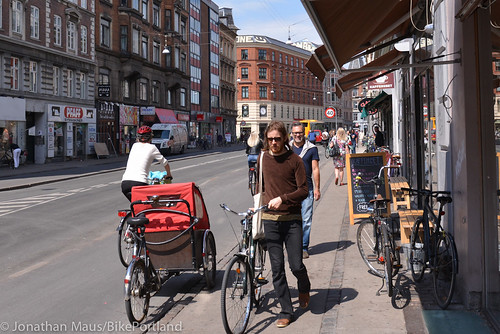
(Photos © J. Maus/BikePortland)
Living in the U.S. it can be difficult to keep the faith in the bicycling vision. The incessant marginalization of cycling by our national transportation culture, reluctant media, and timid leaders can introduce doubt into the minds of even the most fervent bicycle believers. But if there’s one thing that I learned spending two weeks in the best bicycling cities in the world, it’s proof of concept that bicycling can be an essential ingredient to successful public spaces. Despite what the naysayers continue to push back against, once you’ve spent time in cities like Copenhagen and Amsterdam you realize that yes, indeed, it’s absolutely possible to have a low-car city that teems with economic vibrancy and happy, healthy citizens that have access to all the services they need without having to use a car.
Take Nørrebrogade in Copenhagen for instance. This street was transformed back in 2007-2008 by a visionary mayor who had the guts to push a revitalization of this previously lackluster thoroughfare that put people above auto capacity. Nørrebrogade was reconstructed with bus-only priority lanes, cycle tracks that are 16-feet wide in some sections, and improved sidewalks. There is no on-street auto parking and for several blocks, if you want to drive on the street you must turn off it and go around a bus/bike only section. The result is a 50% reduction in auto volume, large increases in people cycling, taking transit, and walking, and a commercial environment that would be envy of any business owner.
According to one analysis, “The municipality’s assessment [of the project] has suggested that it is possible to reduce the volume of car traffic by 50% without negative consequences for the surrounding residential streets.” In other words, people simply decided to drive elsewhere and/or they switched to modes that were more welcome on Nørrebrogade.
“The Nørrebrogade project created a lot of trouble. Business owners said they would be killed.”
— Niels Hoe, former City of Copenhagen manager of bicycle parking
That large reduction in auto traffic is key to understanding why this — and many other streets like it — are a success. Fewer cars means more space, less noise, better air quality, and a safer, comfortable environment that fosters more business and social interactions. One thing it doesn’t mean is a lack of economic vibrancy. In fact, the opposite is true.
“In 2008, the street was dead,” quipped Mikael Colville-Andersen when I chatted with him about Nørrebrogade. Colville-Andersen, the noted bicycle blogger behind Copenhagenize (not to mention author, photographer, speaker, international mobility consultant, and so on), credits the Nørrebrogade project to former Mayor Klaus Bondham. What started initially as a pilot project, he said, has now become a model and the City of Copenhagen plans to recreate its success on other streets.
Niels Hoe, a former City employee who worked on bicycle parking and planning, said even in Copenhagen such an ambitious undertaking wasn’t easy. “The Nørrebrogade project created a lot of trouble,” Hoe shared during an interview in a cafe along the street last when I was there last month. “Business owners said they would be killed.”
Today, businesses are going gangbusters on Nørrebrogade. The sidewalks are full of people (many of them pushing strollers) and the constant stream of people on bikes and in buses provide shop owners with a huge captive market of potential customers. The amount of bike shops alone is staggering: about 50 bike shops (estimates one shop employee I asked) on or near the main stretch of Nørrebrogade.
It’s important to understand that the City of Copenhagen was thoughtful about how they designed the bus and bike facilities: Key design details make Nørrebrogade welcoming for users of both.
The cycle track was purposefully made wide enough for social cycling. It’s easy to carry on a conversation and in sections where it’s especially wide — over 16-feet! — the City has painted small arrows to facilitate passing. (Amazingly, you can ride side-by-side with a friend and have someone pass both of you and still not feel crowded.) Another key design feature of Copenhagen’s cycle tracks are the very small curbs and ramps which allow people on bikes to easily move from the cycle track to the sidewalk or the street. This is important to maintain the flow of bike traffic. If a truck is blocking the cycle track for instance, it’s easy to hop down or up the curb to get around it. If you see a friend on the sidewalk — or an item for sale in a store window that catches your eye — it’s easy to pull over without much effort.
For bus riders, not only is service on Nørrebrogade frequent and fast, the stops are very civilized. Instead of being on the curb, the stops are placed on median islands in the roadway. This keeps the stops and their users off the sidewalk space and it allows bicycle traffic to flow freely behind it. Or, when stops are on the sidewalk, the bus lets off in the main roadway and the doesn’t block the cycle track. Thus, the dreaded “leapfrog” bus/bike dance is completely avoided. (This is exactly the configuration some folks hoped for on N. Williams, but alas, various demands from TriMet squashed the idea early in the process. It’s also what we have today on SW Moody near Gaines in South Waterfront) What happens when a lot of people step off the bus and walk over the cycle track toward the sidewalk? Amazingly, the sky does not fall. People on bikes stop, wait, and everyone manages with no big whoop.
Of course Nørrebrogade is not perfect. In some parts the sidewalk feels cramped and there’s so much bike traffic that the street feels a bit chaotic during rush hour (I happen to love that chaos). Also, when businesses do need truck access, there’s really no place for them to go so they usually straddle the road and the cycle track. In one case I saw a large truck that completely blocked the cycle track while workers moved several pieces of furniture into a store. But in both those cases, no one seemed upset. There were no middle-fingers or yelling from anyone. People just went about their business.
And don’t forget that it’s not just the main street of Nørrebrogade that benefits, there are myriad wonderful side streets that where auto traffic has also been kept in check.
During my time in the Netherlands, I also saw many examples of thriving commercial streets and plazas where bicycling and walking were given the highest priority:
There was Market Square and its side streets in ‘s-Hertogenbosch…
The entire city center of Delft (and other cities) is traffic calmed through the use of bollards…
And then there are bustling business streets like Haarlemmerstraat in Amsterdam which survives pretty much exclusively on biking and walking traffic…
In city after city where people had priority over cars I saw small businesses, public spaces, and life in general — flourishing. How is it possible?! Don’t those businesses need cars to survive? What about emergency vehicle access? What about freight trucks? We are very good in the states at finding reasons we can’t do things; but even though I’m aware this is far beyond an apples-to-apples comparison, it does give me hope to know that there are places in the world where human beings live — and live well — without cars at the center of everything.
— Read more of our coverage from Copenhagen and The Netherlands here.


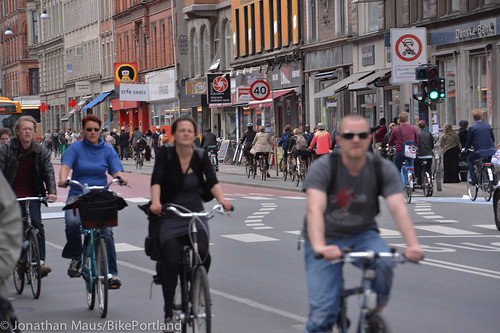

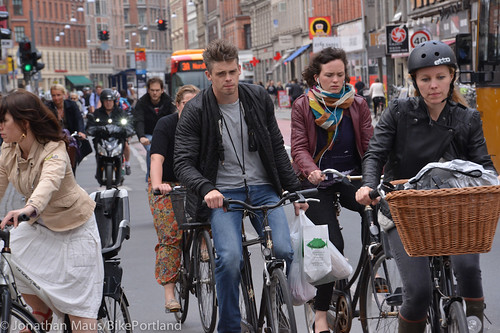
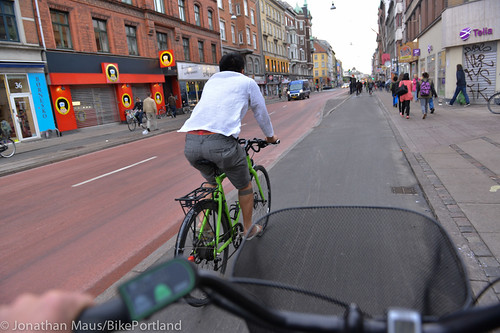
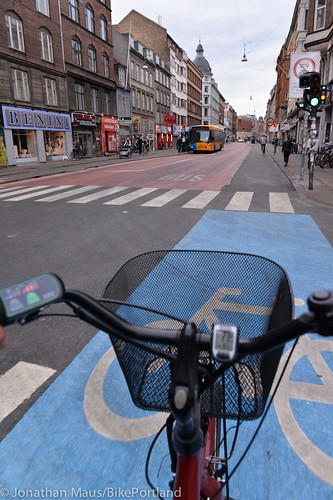


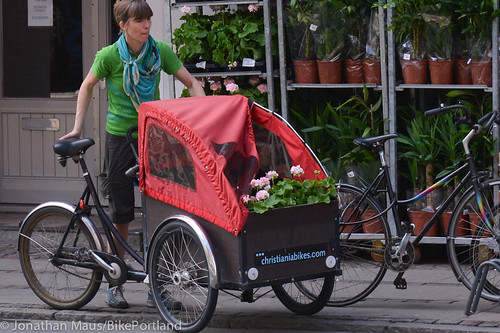
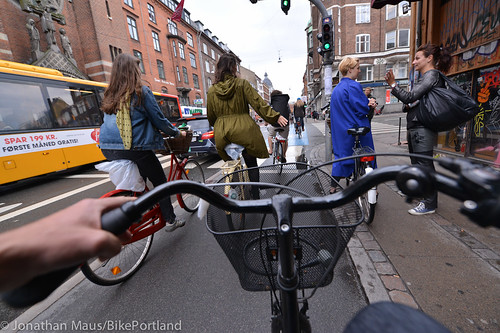

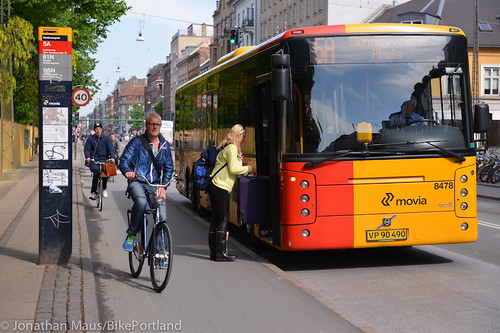
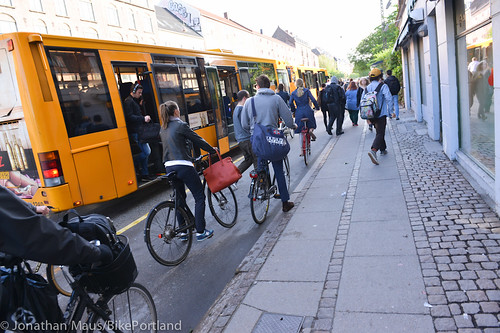
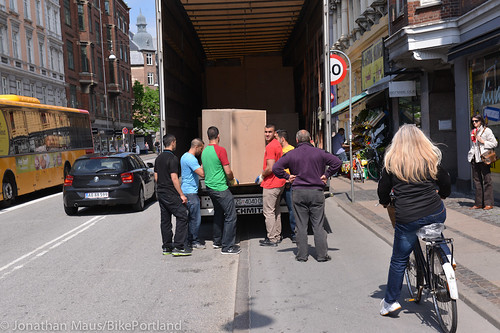

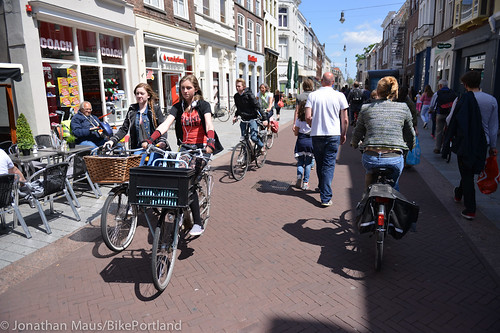

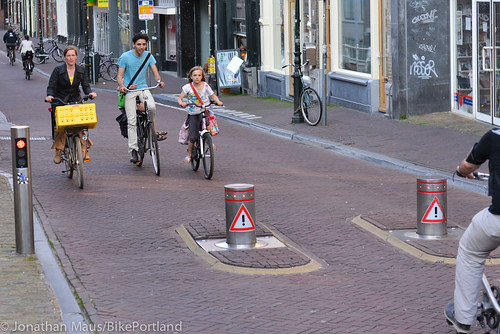

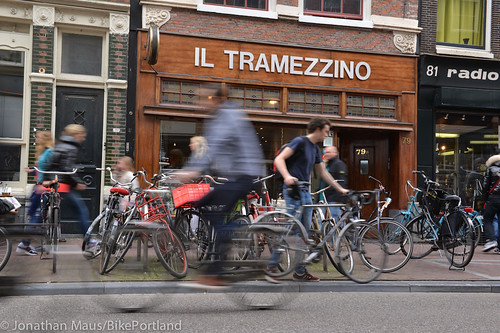
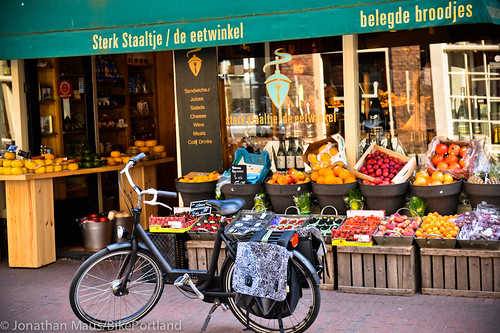
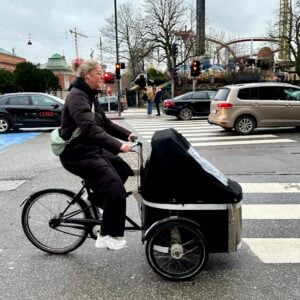

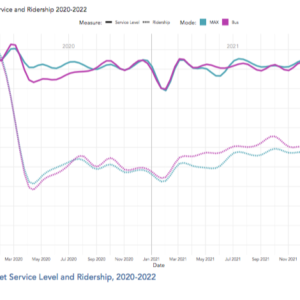
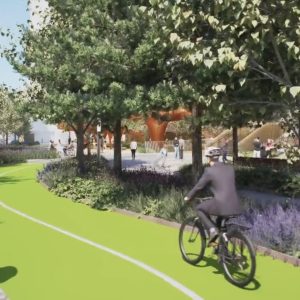
Thanks for reading.
BikePortland has served this community with independent community journalism since 2005. We rely on subscriptions from readers like you to survive. Your financial support is vital in keeping this valuable resource alive and well.
Please subscribe today to strengthen and expand our work.
I think I just cried a little. Jonathan, can we start a petition to make every elected official, city planner, and traffic engineer read this one little article? Then perhaps some of those “can’t”s might at least become “let’s think about this”s.
LoveDoctor, I’m right there crying with you.
The bus system here seems pretty great as well, n’est pas?
Jonathan, did you happen to notice how late and how frequent the buses run?
And now I will keep my rants about Tri-met to myself, ’cause it would never end.
I live next to Nørrebrogade – the 5A bus drives at all hours – every 4 minutes during the day and about every 20 minutes all through the night. Back when Nørrebrogade was heavily congested with cars getting on and off buses was a nightmare – not to mention the snaillike pace they were driving at. Now it’s just fast and efficient.
LLOYD DISTRICT! I’m looking at you! How awesome would that be? Instead of parking lots and office buildings and confused convention center visitors, we could have a neighborhood that I don’t just commute through!
I recently spoke with a senior engineer about adapting the street I live on to prioritize bikes and the bus that runs down it (just lower the volume of cars, really). Her response: “it’s never going to happen, the street works fine the way it is.” That seems to be a common attitude. She wouldn’t even think of changes that might just lower the volume of car traffic. It’s a local service street that gets treated like a neighborhood collector. This same engineer thought the changes made to Clinton years ago were not for the better. With individuals like that working to “make changes,” change won’t look pretty.
I vote that we do a pilot program like this on Hawthorne! Heck why not on Belmont? Or Division? Ha! I keep holding out hope that our streets will continue to change here in Portland. Although I feel that I get around well for my purposes, it sure would be nice to have even calmer roads, designed for people. Thanks for the article and pics Jonathan!
This is nothing new, and certainly not exclusive to Copenhagen. Most cities in Europe have areas like this, even the heart of London and Paris has this!
Portland needs to step up. I think the natural choice would be Belmont, making the setup found during the street fair an everyday arrangement–down to the grassy roundabout!
You would think the vendors on a street would love the traffic passing by storefronts more slowly, as on a bike.
I’ll admit I was thinking about Division Street while reading this article. Belmont could work equally well. Keep the buses, but not the cars. You’d have to deal with existing driveways, but allow cars only to the end of the block. Perhaps it would be a more exciting Bike Boulevard than Clinton!
@AndyC of Linnton
There are two bus lines running along Nørrebrogade, the 5A city bus (every 4 minutes) and the 350S through bus (every 7-9 minutes).
This article is a totally one-sided propaganda like story. I live on Nørrebro, the success is killing the biking, way too many people, impatience, etc, just like car traffic when it becomes too much. Whats even worse, most bikers do not respect the traffic rules, neither do they respect pedestrians or people going to and from the bus.There are lots of empty shops now because they have gone bankrupt, one of the reasons being that no cars can get around with stuff that cannot be carried on a bike. Besides 90% of the traffic goes straight through. And there are far from 50 bikeshops on the street, its 15 at the most. Most of them have been here before 2008. I work with a local council, which is looking into these problems constantly. Sorry, but this article is way too glamorous a story.
My comments on this post are here:
bikeportlandwatch.blogspot.com/2013/06/maus-on-nrrebrogade-in-copenhagen.html
tinyurl.com/nr9f769
Nice website.
You are like the anti-bike infrastructure version of Jim Karlock:
http://www.debunkingportland.com/
According to the latest report about the project the number of shops on Nørrebrogade fell with just 4 from 2005 to 2010. Pretty okay taking the financial crisis into account.
I live on Nørrebro too. And this project has been amazing. Today its actually possible to have a conversation on this street without having to raise your voice. Official statistics show a noise level reduction of 45 percent.
Other statistics:
Number of cars a day is down with 60 percent (from 15.000 to 6.000)
Number of pedestrians a day is up with 60 percent (from 4.731 to 7.616)
Number of bikes a day is up with 20 percent (from 30.000 to 36.000)
Number of traffic accidents over a 33 month period is down with 49 percent (from 51 to 26)
https://subsite.kk.dk/~/media/6EC15E8C14A849A8A63C39D16C213EEB.ashx
(Unfortunately only in Danish)
Well the 4 shops that dissapperared is actually a gross number, it does not take into account only the shops that had to close, but also includes new shops. I.e. shops that closed minus new shops that opened = 4. The report also mentions that the street need to be supported better as a street for shops and businesses, so the report actually admits that this is a problem.
Don’t forget the sender and creator of the report: the same administration that decided the project. Not entirely an unbiased report. Besides, the Copenhagen City Council have on several occasions released reports that are both biased and untruthful. The conclusions are somewhat not entirely correct. I don’t trust reports that come from that council…and I have seen and read many of them.
The motorised traffic reduction is also due to other construction projects that block the road for that traffic, which is also mentioned in very few words in the report. They expect a total motorised traffic reduction of only 10-15% when those other projects are complete.
Noise level reduction, definitely true, but we still have those annoying noisy and extremely polluting buses that drive up and down the street. But I never had to raise my voice on that street to be heard, even before 2008.
Besides, many have called the street pretty dead after 2008. And once again, 50 bike shops is a total overexaggeration. Its only 10 or something, and only one or two are new.
I am not against it, I think it is fine, I use my bike every day anyhow. But, when making such a project there are many things you need to take into account, especially commerce and business, and how they can survive best with such a huge change. Besides, we don’t want a café street with nothing but latté shops and shawarma bars. We want diversity too.
Isn’t the gross number kind of the important factor here? Of course, when you change the primary mode of transportation, the kinds of shops which need to be open will change.
For example, if there was a shop which earlier sold huge pieces of furniture, it is unlikely that it would survive the transition, since furniture is something people do need a car/truck to purchase. However, the fact that the gross number has reduced by 4 means that the economic activity did not go down, since that shop was replaced by another shop which better served the new type of street this is.
I can’t believe anyone would complain about losing only 4 shops on a large street like this from before the financial crisis, to its worst phase (2009-2010).
Oh and those buses are totally cramped, 5A is actually the one in northern europe with the highest ridership. This makes LRT or tramlines the perfect substitute for those buses, giving even less noise and much less pollution.
No mention of disabled access. How are the less physically able accommodated in this scheme?
Very carefully. In general, it allows disabled persons to have a greater degree of mobility than they have here in America (assuming that you’re here too). In most cases, they can make use of the same infrastructure that bike riders can.
https://www.youtube.com/watch?v=xSGx3HSjKDo